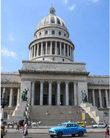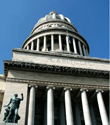
| |
| overview |
| attractions |
| cities |
| hotels |
| airfare |
| contact |
Capitolio Nacional, Cuba |
|
* Cuba overview * getting there * cities * hotels * Bellamar caves * Castillo de la Real Fuerza * Delfinario * El Malecon * Museum of the Revolution * Trinidad * attractions guide * As the capital city of Cuba, Havana features many of the country’s best museums, architectural sites, and other tourist attractions. A major feature of the Havana skyline, the Capitolio Nacional Cuba is a splendid monument to pre-revolutionary Cuban history and a great place to visit on any Cuban vacation. This elaborate building in the capital of Cuba was designed by the architects Raúl Otero and Eugenio Raynieri. The design features tall granite columns, a huge statue-flanked stairway leading to a 150-foot high entrance, and a 300-foot high dome topped by a replica of a sixteenth-century Fiorentine sculpture of the god Mercury. The Capitolio Nacional Cuba contains the third largest indoor sculpture in the world (after the Buddha sculpture in the temple complex of Nara Japan and the sculpture of Abraham Lincoln in Washington DC’s Lincoln Memorial). The Statue of the Republic (Estatua de la Republica) is an idealized representation of Cuban nationalism modeled after a beautiful Cuban female model, Lily Valty. Cast in bronze and covered in 22-carat gold leaf, the statue dominates the main hall of the Capitolio Nacional. Another impressive feature of the Capitolio Nacional Cuba is a replica of a 25-carat diamond in the center of the main lobby, marking Kilometer Zero in Cuba. The original diamond was stolen in 1946 and though returned to the Cuban state, was replaced in the Capitolio Nacional by a replica. The bas-reliefs above the main doorways are also worth a look: they depict important events from pre-revolutionary Cuban history. In the years before the Cuban revolution, the Capitolio Nacional was home to Cuba’s legislature. Since the 1960s, the architectural splendor in the capital city of Cuba has housed the Ministry of Science, Technology, and the Environment. The National Library of Science and Technology is housed in the rear of the building. The bottom floor of the Capitolio Nacional is open to the public. The impressive building in the capital of Cuba has become one of Havana’s most popular tourist attractions. OVERVIEW for your visit to Cuba: introduction * when to go * things to do * events * getting there * getting around * food * history * attractions * music * cities * hotels |
| SIGHTS OF CUBA | ||
|
||

